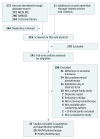Phototherapy for Vitiligo: A Systematic Review and Meta-analysis
- PMID: 28355423
- PMCID: PMC5817459
- DOI: 10.1001/jamadermatol.2017.0002
Phototherapy for Vitiligo: A Systematic Review and Meta-analysis
Abstract
Importance: References to the expected treatment response to phototherapy would be helpful in the management of vitiligo because phototherapy requires long treatment durations over several months.
Objective: To estimate the treatment response of vitiligo to phototherapy.
Data sources: A comprehensive database search of MEDLINE, EMBASE, and the Cochrane library from inception to January 26, 2016, was performed for all prospective studies. The main keywords used were vitiligo, phototherapy, psoralen, PUVA, ultraviolet, NBUVB, and narrowband.
Study selection: All prospective studies reporting phototherapy outcome for at least 10 participants with generalized vitiligo were included. Of 319 studies initially identified, the full texts of 141 studies were assessed for eligibility, and 35 were finally included in the analysis. Of these, 29 studies included 1201 patients undergoing narrowband UV-B (NBUVB) phototherapy, and 9 included 227 patients undergoing psoralen-UV-A (PUVA) phototherapy.
Data extraction and synthesis: Two reviewers independently extracted the following data: study design, number and characteristics of the participants, phototherapy protocol, and rate of repigmentation based on the quartile scale. Single-arm meta-analyses were performed for the NBUVB and PUVA groups. Sample size-weighted means were calculated using a random-effects model for the repigmentation rates of the included studies.
Main outcomes and measures: The primary outcomes were at least mild (≥25%), at least moderate (≥50%), and marked (≥75%) responses on a quartile scale. Response rates were calculated as the number of participants who showed the corresponding repigmentation divided by the number of all participants enrolled in the individual studies.
Results: The meta-analysis included 35 unique studies (1428 unique patients). For NBUVB phototherapy, an at least mild response occurred in 62.1% (95% CI, 46.9%-77.3%) of 130 patients in 3 studies at 3 months, 74.2% (95% CI, 68.5%-79.8%) of 232 patients in 11 studies at 6 months, and 75.0% (95% CI, 60.9%-89.2%) of 512 patients in 8 studies at 12 months. A marked response was achieved in 13.0% (95% CI, 2.1%-23.9%) of 106 patients in 2 studies at 3 months, 19.2% (95% CI, 11.4%-27.0%) of 266 patients in 13 studies at 6 months, and 35.7% (95% CI, 21.5%-49.9%) of 540 patients in 9 studies at 12 months. For PUVA phototherapy, an at least mild response occurred in 51.4% (95% CI, 28.1%-74.7%) of 103 patients in 4 studies at 6 months and 61.6% (95% CI, 20.2%-100%) of 72 patients in 3 studies at 12 months. In the subgroup analyses, marked responses were achieved on the face and neck in 44.2% (95% CI, 24.2%-64.2%), on the trunk in 26.1% (95% CI, 8.7%-43.5%), on the extremities in 17.3% (95% CI, 8.2%-26.5%), and on the hands and feet in none after at least 6 months of NBUVB phototherapy.
Conclusions and relevance: Long-duration phototherapy should be encouraged to enhance the treatment response in vitiligo. The greatest response is anticipated on the face and neck.
Conflict of interest statement
Figures


References
-
- Alikhan A, Felsten LM, Daly M, Petronic-Rosic V. Vitiligo: a comprehensive overview, part I: introduction, epidemiology, quality of life, diagnosis, differential diagnosis, associations, histopathology, etiology, and work-up. J Am Acad Dermatol. 2011;65(3):473-491. - PubMed
-
- Ongenae K, Beelaert L, van Geel N, Naeyaert JM. Psychosocial effects of vitiligo. J Eur Acad Dermatol Venereol. 2006;20(1):1-8. - PubMed
-
- Felsten LM, Alikhan A, Petronic-Rosic V. Vitiligo: a comprehensive overview, part II: treatment options and approach to treatment. J Am Acad Dermatol. 2011;65(3):493-514. - PubMed
-
- Njoo MD, Spuls PI, Bos JD, Westerhof W, Bossuyt PM. Nonsurgical repigmentation therapies in vitiligo: meta-analysis of the literature. Arch Dermatol. 1998;134(12):1532-1540. - PubMed
-
- Moher D, Liberati A, Tetzlaff J, Altman DG; PRISMA Group . Preferred reporting items for systematic reviews and meta-analyses: the PRISMA statement. J Clin Epidemiol. 2009;62(10):1006-1012. - PubMed
Publication types
MeSH terms
Substances
LinkOut - more resources
Full Text Sources
Other Literature Sources
Medical

